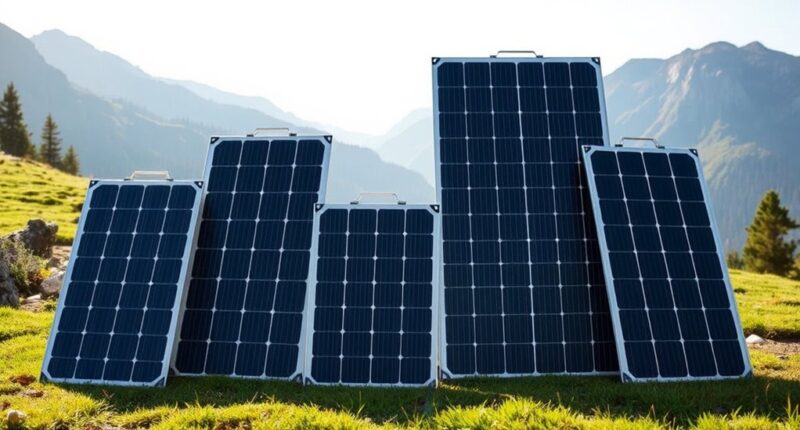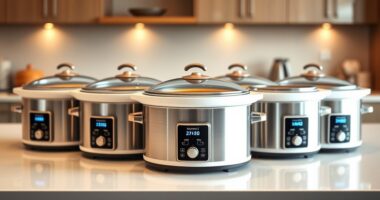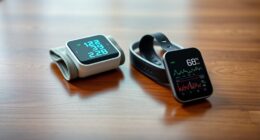If you’re looking for the best portable solar panels for camping and home use in 2025, I recommend options like the ZeroKor 300W Power Station with a foldable panel, the Anker SOLIX C300 with its durable design, and the DOKIO 150W foldable kit. These models offer great power output, portability, and weather resistance. Keep exploring further to find out which one fits your specific needs best and how to choose the right system.
Key Takeaways
- Prioritize panels with 100W+ output for faster charging and reliable power during camping or home backup.
- Choose lightweight, foldable designs under 10 pounds for easy portability and quick setup outdoors.
- Ensure panels have weatherproof features like IP65/IP68 ratings and durable construction for outdoor durability.
- Opt for high-efficiency monocrystalline panels with MPPT controllers to maximize charging speed in various sunlight conditions.
- Consider specific use cases, such as emergency kits or RV-compatible panels, to match your power needs and activities.
Portable Solar Generator, 300W Power Station with Foldable Solar Panel

If you’re looking for a lightweight and portable power solution for camping or emergency use at home, the ZeroKor 300W Portable Solar Generator is a solid choice. It includes a foldable 60W monocrystalline solar panel, a 280Wh lithium-ion battery, and multiple outlets for charging devices. With 2 AC outlets, USB ports, and a flashlight, it’s versatile for small electronics and outdoor needs. Weighing just over 5 pounds, it’s easy to carry and set up. While the solar panel performs well in direct sunlight, some users report limited power output and charging issues. Overall, it’s best for low-wattage devices and emergency backup rather than high-demand appliances.
Best For: emergency preparedness, outdoor camping, and powering small electronic devices during short-term outages or outdoor activities.
Pros:
- Lightweight and portable, weighing just over 5 pounds for easy transport
- Multiple charging options including AC, USB, and DC ports for versatile device compatibility
- Built-in protection features like BMS to ensure safety during use
Cons:
- Solar panel may have limited power output and inconsistent charging performance
- Actual power output often less than rated 300W, unsuitable for high-wattage appliances
- Non-pure sine wave AC outlets may affect sensitive electronics and cause glitches
Anker Solar Generator SOLIX C300 with 60W Solar Panel, Portable Power Station
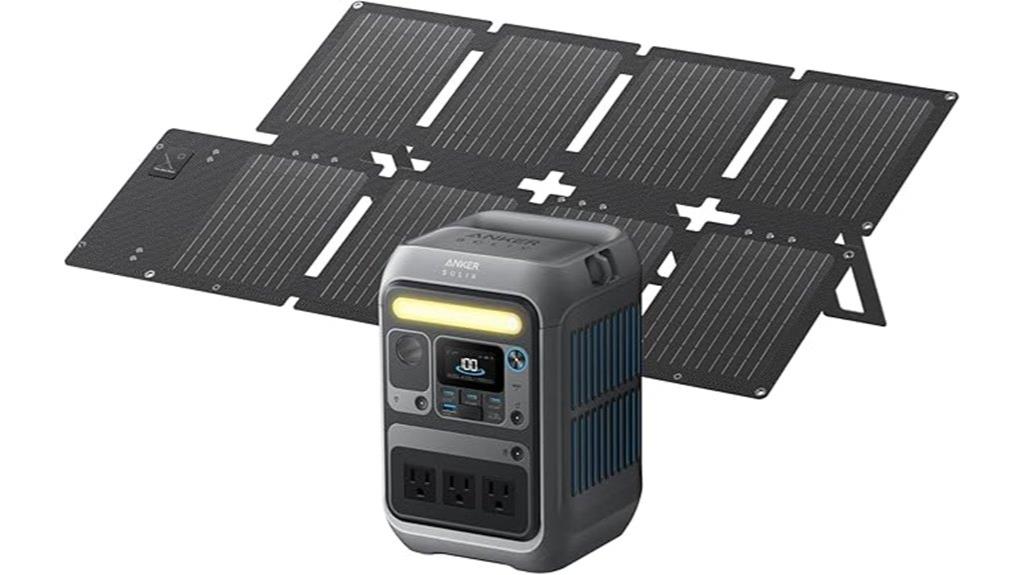
The Anker Solar Generator SOLIX C300 with its 60W foldable solar panel is an excellent choice for outdoor enthusiasts who need reliable, portable power for camping or emergency use. Weighing just 15.47 pounds and measuring around 6.45 inches, it’s compact and travel-friendly, with a durable, impact-resistant design. Its 288Wh capacity and 300W continuous output easily power laptops, small appliances, and devices, while the eight versatile outlets support multiple gadgets simultaneously. The included waterproof solar panel generates up to 52W under ideal conditions and charges the station efficiently, making it a sustainable, quiet energy source perfect for outdoor adventures or backup power.
Best For: outdoor enthusiasts, campers, and emergency preparedness users seeking a portable, reliable power source for various devices and small appliances.
Pros:
- Compact, lightweight design weighing only 15.47 pounds for easy portability
- Durable LiFePO4 batteries rated for 3,000 cycles ensuring long-lasting performance
- Multiple charging options including AC outlets, USB-C, USB-A, car socket, and solar input for versatile recharging
Cons:
- Limited USB ports may require additional adapters for multiple device charging
- No default strap included, which could affect carrying convenience for some users
- Not suitable for backpacking or hiking due to its size and weight despite being travel-friendly
DOKIO 150W Portable Foldable Solar Panel Kit

The DOKIO 150W Portable Foldable Solar Panel Kit stands out as an excellent choice for campers and outdoor enthusiasts seeking reliable, lightweight power on the go. Its compact 21×20-inch design weighs just 7.3 pounds, folding down to 19.3×20.9×1.1 inches for easy packing and solo setup. Made with high-efficiency monocrystalline cells, it performs well even in low light. The weather-resistant surface guarantees durability in outdoor conditions. It includes a PWM controller with full protections, USB ports for direct device charging, and a long cable to keep the panel in the sun while the controller stays cooler. Perfect for RVs, camping, or backup power.
Best For: outdoor enthusiasts, campers, and RV owners seeking a lightweight, portable solar solution for off-grid power needs.
Pros:
- Compact and lightweight design for easy transport and solo setup
- High-efficiency monocrystalline cells for better energy output in low light
- Weather-resistant surface and full safety protections ensure durability and safe operation
Cons:
- Output may be limited to device input caps (60–100W), potentially reducing maximum power usage
- Prolonged exposure to heavy rain or intense sunlight on fabric cases should be avoided
- Some power stations may not accept the full 150W output, requiring verification before purchase
Portable Power Station with Foldable Solar Panel (146Wh)
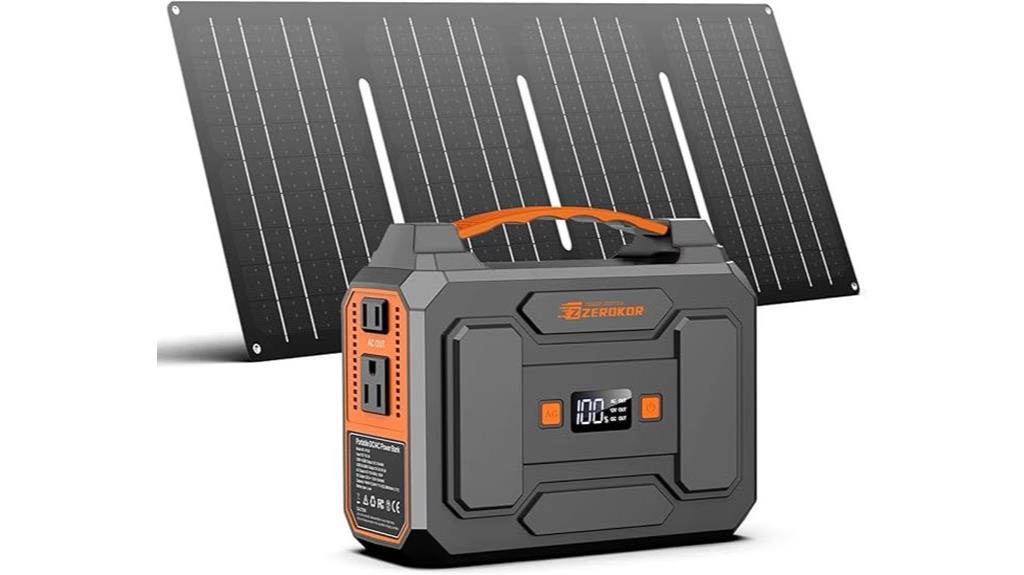
A 146Wh portable power station paired with a foldable solar panel offers an excellent solution for outdoor enthusiasts and emergency preparedness. The ZeroKor kit includes a 100W lithium-ion battery and a 40W monocrystalline solar panel, making it ideal for charging smartphones, laptops, cameras, and small appliances under 100W. It features multiple outputs—AC, USB, and DC—and a built-in flashlight with SOS mode for emergencies. Recharging is flexible, via wall, solar, or car. Its high-efficiency solar panel performs well in low-light conditions, and safety features like BMS protect against overloads. Compact and lightweight, this kit is perfect for camping, hiking, or power outages.
Best For: outdoor enthusiasts, campers, and emergency preppers seeking reliable off-grid power for small devices and appliances under 100W.
Pros:
- High conversion efficiency of 20.5% in the solar panel ensures effective charging even in low-light conditions.
- Multiple output options including AC, USB, and DC cater to a variety of devices.
- Compact, lightweight design with a foldable solar panel makes it portable and easy to carry.
Cons:
- The solar panel’s junction box is not waterproof, requiring protection from moisture.
- Not suitable for appliances over 100W, limiting its use for larger devices.
- Recharging via solar panel depends on sunlight availability, which may vary in different environments.
Solar Powered Generator 300W Portable Power Station with Solar Panels
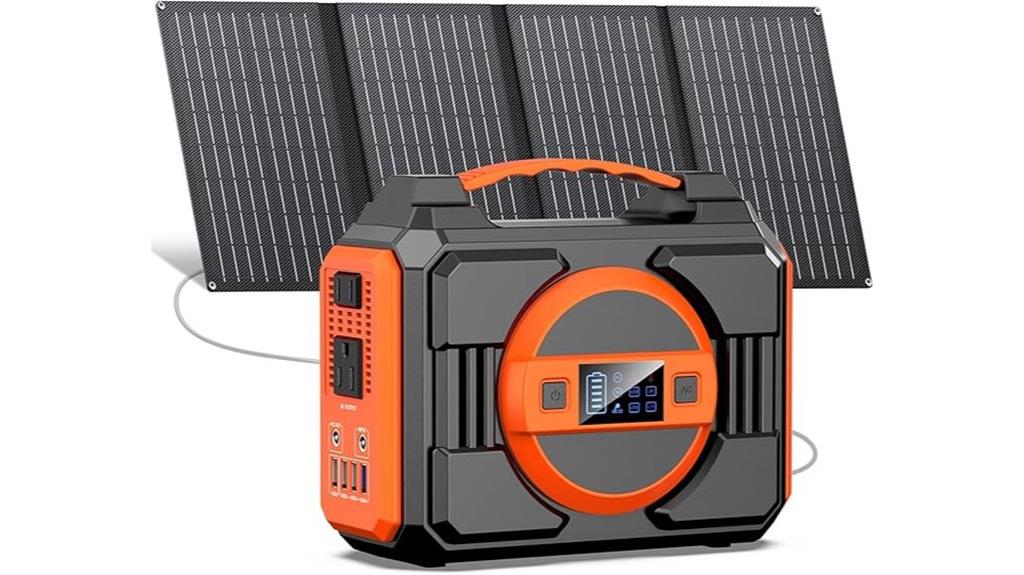
If you’re looking for a compact, reliable power source for camping or home backup, the Solar Powered Generator 300W Portable Power Station with Solar Panels is an excellent choice. It features a 220Wh lithium-ion battery housed in a lightweight 5-pound frame, making it easy to transport. The included 40W monocrystalline solar panels offer high conversion efficiency at 24%, compatible with most portable generators. With 7 output ports—AC, USB, USB-C, and DC—it can power multiple devices simultaneously. Its advanced safety features, bright LED light, and sturdy design guarantee safe, versatile, and efficient off-grid or emergency use.
Best For: outdoor enthusiasts, campers, and homeowners seeking a portable, reliable backup power source for emergency or off-grid use.
Pros:
- Compact and lightweight design (5 lbs) for easy portability and transport
- Multiple output options including AC, USB, USB-C, and DC ports for versatile device charging
- High-efficiency 24% monocrystalline solar panels enhance charging speed and compatibility
Cons:
- Limited 300W rated power may not support high-wattage appliances
- Battery capacity of 220Wh may require frequent recharging for extended use
- Some users might find the number of ports insufficient for larger device setups
Factors to Consider When Choosing a Portable Solar Panel for Camping and Home
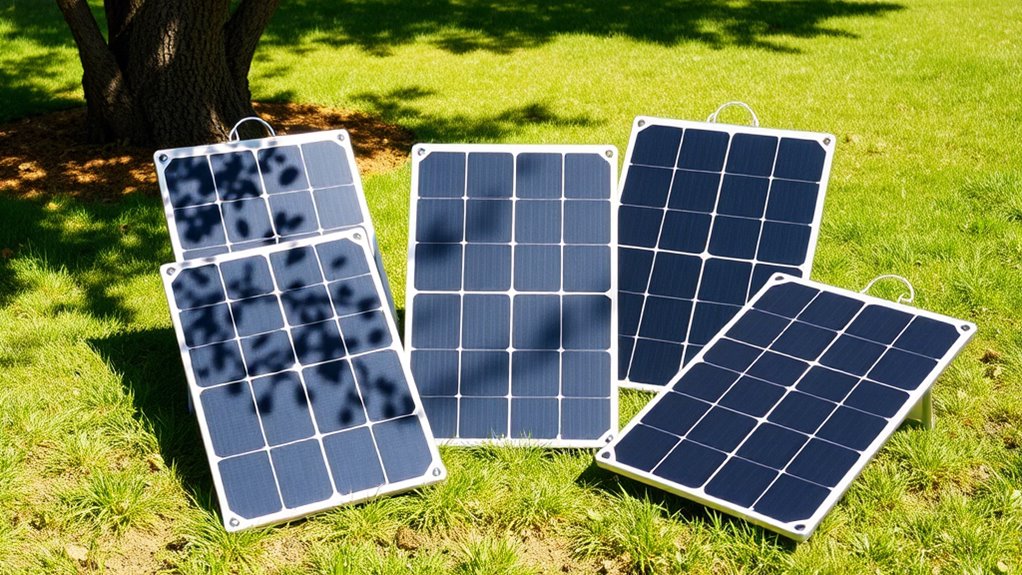
When choosing a portable solar panel, I focus on several key factors to get the best fit for my needs. I consider the power output, size, durability, compatibility, and how quickly it charges my devices. These points help me select a panel that’s efficient, reliable, and easy to take anywhere.
Power Output Capacity
Choosing the right portable solar panel hinges on matching its power output capacity to your energy needs. I always check the maximum wattage to guarantee it can handle my devices, especially if I want to charge larger batteries or run multiple gadgets at once. For bigger power demands, I prefer panels with 100W or more, which charge faster and provide reliable energy. It’s also essential to verify that the panel’s voltage and current match my power station or battery system for proper charging. Keep in mind, actual power depends on sunlight conditions, so higher capacity panels help compensate for less-than-ideal sunlight. Ultimately, selecting a panel with sufficient wattage ensures I get efficient, consistent power when I need it most.
Portability and Size
Portability and size are essential factors to take into account because they directly impact how easily I can transport and set up my solar panels. I look for lightweight designs under 10 pounds, making them simple to carry during camping trips. Smaller panels, typically around 100-150W, are ideal because their compact size fits easily into backpacks or storage cases. Foldable models often measure less than 20 inches when folded, which helps me manage space and convenience. Features like carrying handles, included storage cases, and quick setup mechanisms further simplify transportation and deployment. Whether I’m heading into the woods or setting up at home, choosing a panel that’s easy to carry and set up makes the entire experience more enjoyable and stress-free.
Durability and Weatherproofing
Durability and weatherproofing are essential because outdoor conditions can be unpredictable and harsh. I look for panels built with high-quality monocrystalline or polycrystalline cells, which can handle physical stress and environmental challenges. Weatherproof features like IP ratings (such as IP65 or IP68) ensure the panels resist rain, dust, and splashes, making them reliable in diverse conditions. Reinforced frames and corrosion-resistant materials extend the lifespan, especially in rugged outdoor settings. Sealed junction boxes and protective coatings prevent moisture ingress and UV damage, maintaining performance over time. I also check for panels tested against impact, bending, and temperature fluctuations, so I can trust they’ll perform reliably during camping trips or home use, no matter the weather.
Compatibility and Connectors
Since the right connectors are indispensable for seamless power transfer, I always check that a portable solar panel has compatible connectors like MC4, Anderson, or DC to match my devices or power station. I look for panels that include multiple adapters or cables, guaranteeing I can connect with various portable power stations easily. It’s essential to verify that the voltage and current ratings of the connectors match my device’s requirements to avoid damage or inefficiency. I also prefer panels with universal or adaptable connectors that can switch between different port types, adding versatility. Additionally, I ensure the connectors are weather-resistant and suitable for outdoor use, which is critical for camping and outdoor setups. Proper compatibility guarantees safe, efficient, and hassle-free power transfer.
Charging Speed and Efficiency
When selecting a portable solar panel, understanding how quickly it can recharge your devices or power stations is vital. The charging speed depends largely on its wattage output and the efficiency of its charge controller—MPPT or PWM. Higher wattage panels, like 150W or 200W, can recharge power stations faster than smaller ones, especially in ideal sunlight. Sunlight conditions play an essential role; direct, unobstructed sunlight maximizes power generation. Monocrystalline panels typically offer higher efficiency, around 20-24%, which helps improve charging speed. Additionally, MPPT technology optimizes energy extraction by continuously adjusting the electrical load, guaranteeing you get the most out of each sunbeam. Overall, a combination of high wattage, superior panel efficiency, and advanced charge controllers guarantees faster, more reliable charging.
Ease of Setup
Choosing a portable solar panel that’s easy to set up can make a big difference, especially when you’re outdoors or need quick power solutions. Lightweight, foldable designs are ideal—they allow for fast setup without tools, saving time and effort. Look for panels with integrated stands or kickstands that can be adjusted easily to catch the ideal sunlight angle. Panels with clear, step-by-step instructions or automatic deployment features further simplify the process, making setup almost effortless. Built-in controllers or connectors also streamline connecting to batteries or devices, reducing the need for extra accessories or technical knowledge. Additionally, weather-resistant materials and sealed connections ensure safety and reliability in various outdoor conditions, giving you peace of mind while focusing on enjoying your adventure or completing your tasks.
Price and Warranty
Price and warranty are key factors to contemplate when selecting a portable solar panel, as they directly impact your long-term investment and peace of mind. Higher-priced panels often come with longer warranties, sometimes up to 25 years, providing reassurance against defects and performance issues. Many manufacturers offer warranties that cover both product defects and efficiency, ranging from 1 to 25 years, with premium models typically offering extended coverage. A standard warranty generally includes at least 12 months, but investing in a more expensive panel with a longer warranty can be more cost-effective over time. Warranties help protect your investment by covering repairs, replacements, or refunds if the panel fails prematurely. Comparing prices alongside warranty details ensures you get the best value for your money.
Frequently Asked Questions
How Long Do Portable Solar Panels Typically Last Outdoors?
Portable solar panels typically last between 25 to 30 years outdoors with proper care. I’ve found that their lifespan depends on factors like exposure to harsh weather, dirt, and how well I maintain them. Regular cleaning and avoiding extreme conditions help extend their life. While the actual panels might degrade gradually, most come with warranties that guarantee I get several years of reliable use, making them a smart long-term investment.
Can Portable Solar Panels Be Used During Cloudy or Rainy Days?
I’ve found that portable solar panels can still serve you during cloudy or rainy days, though their power productivity might plummet. Clouds can considerably diminish sunlight, reducing energy output, and rain can cause safety concerns. However, some panels are designed with high-efficiency technology that captures diffused sunlight. So, while they’re not perfect on gloomy days, they still generate some juice, making them a handy helper during less-than-ideal weather.
Are Portable Solar Panels Compatible With All Types of Batteries?
Yes, portable solar panels are compatible with many types of batteries, but it’s important to verify their specific requirements. I always make sure the panel’s voltage and current match my battery’s specifications. Using the right charge controller helps prevent overcharging or damage. If you’re unsure, I recommend consulting the battery manufacturer or a solar expert to ensure compatibility and maximize your system’s efficiency.
What Is the Average Weight of Most Portable Solar Panels?
Most portable solar panels weigh between 3 to 10 pounds, making them easy to carry around. I find it fascinating that some ultra-light models weigh less than a gallon of milk! These lightweight panels are perfect for camping or emergency power, offering portability without sacrificing efficiency. When choosing one, consider your needs for weight and power output — you’ll want a balance that fits your adventures or home setup.
How Do I Properly Maintain and Clean Portable Solar Panels?
To properly maintain and clean your portable solar panels, I recommend regularly inspecting for dirt, dust, and debris. I gently wipe the surface with a soft, damp cloth and avoid harsh cleaners. Keep them in a shaded, cool place when not in use, and make certain they’re angled correctly for maximum sunlight exposure. This routine keeps your panels efficient and prolongs their lifespan.
Conclusion
Choosing the right portable solar panel is like finding a reliable friend who’s always ready to light up your adventures and home. Whether you need a compact generator or a foldable panel, each option offers a spark of independence and sustainability. Just remember to contemplate your power needs and portability. With the right gear, you’ll have sunshine on your side, turning cloudy days into opportunities to shine bright wherever life takes you.
